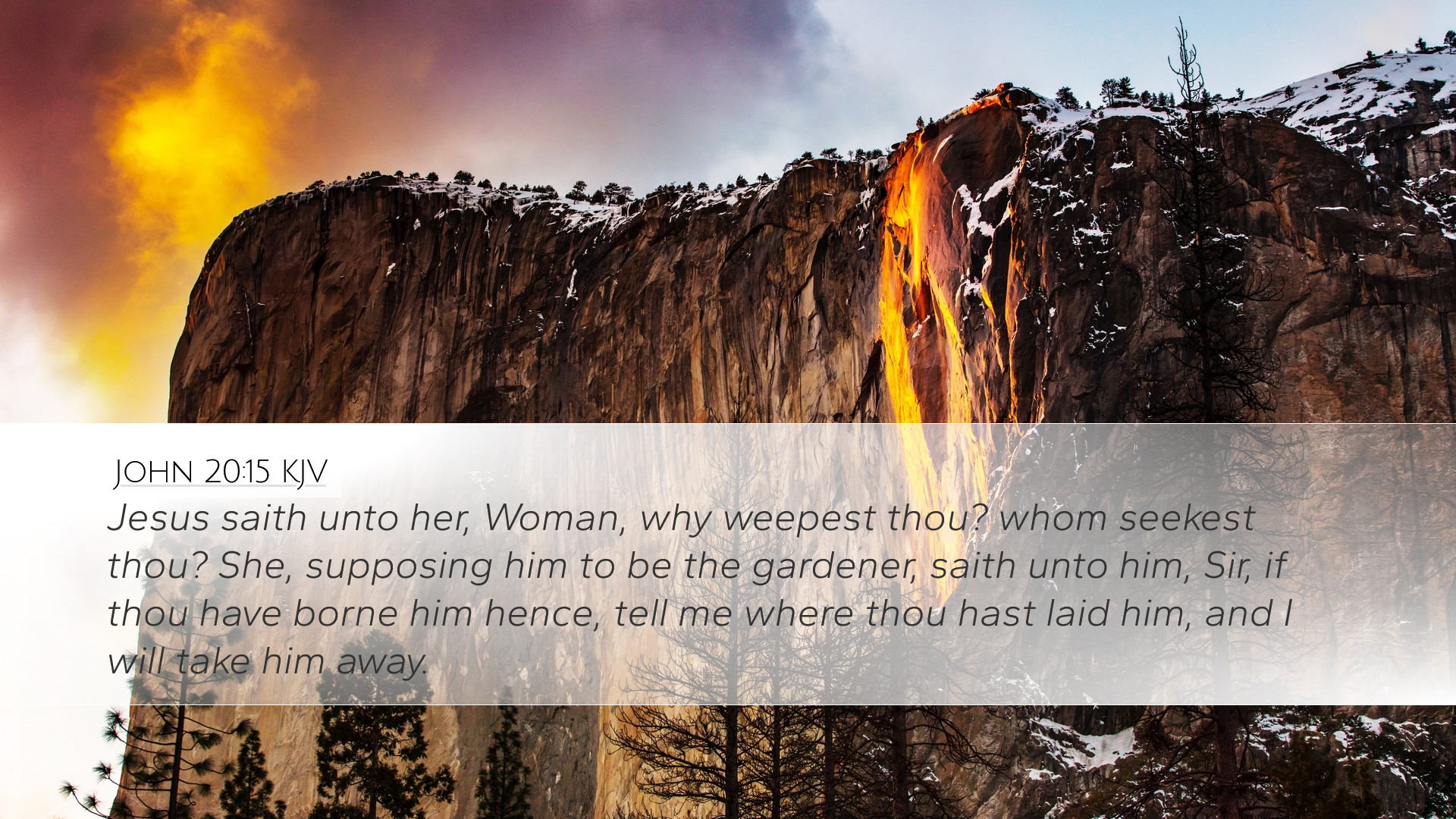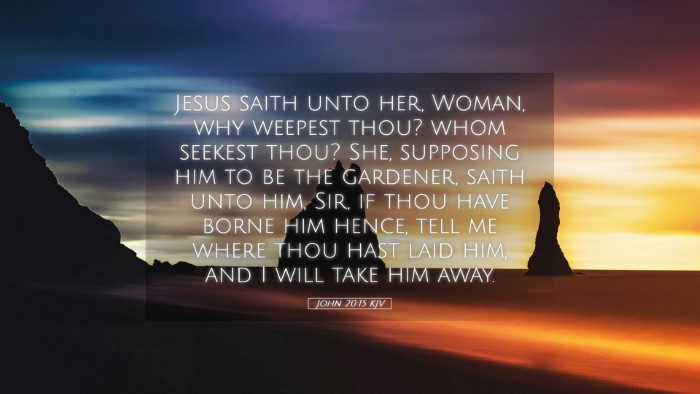Commentary on John 20:15
John 20:15 states, "Jesus said to her, 'Woman, why are you weeping? Whom are you seeking?'" This moment occurs post-resurrection, at the empty tomb where Mary Magdalene encounters Jesus.
Context and Background
To fully grasp this verse, we must consider the emotional and cultural context surrounding Jesus’ resurrection. Mary Magdalene, one of Jesus’ most devoted followers, is in deep sorrow, having witnessed the crucifixion and now the absence of Jesus’ body. Her grief is that of loss and confusion, particularly in the face of the miraculous resurrection.
The Question: "Why are you weeping?"
Jesus’ first question to Mary invites reflection on her emotional state. As noted by Matthew Henry, this query reveals the compassion inherent in Jesus' character, urging Mary to confront the source of her sorrow. Despite the profound loss she feels, Jesus' approach is gentle, demonstrating His understanding of human grief.
Insights from Matthew Henry
- Understanding Grief: Henry expounds that Jesus does not dismiss Mary’s grief but rather addresses it, signifying that it is permissible to grieve the loss of loved ones.
- Compassion in Inquiry: His question prompts self-examination, inviting believers to articulate their own sorrows and concerns before God.
Seeking the Right One
Following His question, Jesus asks, "Whom are you seeking?" This question is profound, as it directs Mary’s focus from her grief to the person of Christ himself. Albert Barnes emphasizes the significance of seeking Jesus amid trials and tribulations, illuminating the importance of directing one's affections and spiritual pursuit towards Him.
Insights from Albert Barnes
- Finding Jesus in Our Sorrow: Barnes asserts that often in our distress, we fail to recognize Jesus; He is present yet unseen.
- Spiritual Pursuit: The question encourages believers to evaluate who or what they are truly seeking in life—comfort, answers, or fulfillment—leading them back to a relationship with Christ.
Mary's Response and Recognition
Mary initially perceives Jesus as the gardener, a testament to her emotional state clouding her recognition of the risen Lord. According to Adam Clarke, this moment illustrates the difficulty believers often face in recognizing Jesus amidst their struggles.
Insights from Adam Clarke
- Recognition in Relationship: Clark emphasizes that recognition of Jesus is not automatic; it necessitates a personal relationship and spiritual awakening.
- The Garden Imagery: The setting of the garden is rich in theological significance, indicating new creation and resurrection life, thus linking Mary’s encounter to the biblical motif of God walking with His people in the garden.
Theological Implications
This verse communicates profound theological truths about the nature of Jesus and His relationship with humanity:
- Compassionate Savior: Jesus approaches Mary in her despair, encapsulating His role as a compassionate and understanding Savior.
- Hope in Resurrection: The empty tomb signifies hope and new life; Jesus’ questions not only address immediate sorrow but also redirect focus to the future and what He has promised.
- Call to Discipleship: This encounter is not merely personal but a missional pivot, where Jesus soon instructs Mary to go and tell the others, highlighting the believers' call to bear witness of the resurrection.
Practical Application
For pastors, students, and theologians, John 20:15 offers several points for reflection and application:
- Emotional Honesty: It encourages believers to bring their honest emotions before God, acknowledging their sorrow and seeking Him amidst pain.
- Importance of Seeking: This passage calls the faithful to reevaluate their pursuits, directing attention to their relationship with Christ.
- Community Engagement: As Mary became the first witness to the resurrection, believers are called to share the hope of Christ's resurrection with others.
Conclusion
John 20:15 embodies the intersection of sorrow and hope. It serves as a poignant reminder that in moments of deep distress, Jesus is intimately present, inviting us into relationship and urging us to seek Him above all else. This passage not only addresses personal grief but also positions believers as messengers of the transformative power of the resurrection.


